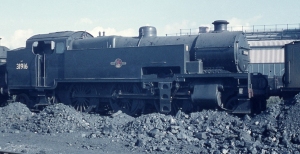Three years ago we published an article about Maunsell’s ill-fated K (or River) class. The K class were a 2-6-4T design that were later converted into 2-6-0 U class tender locomotives as a result of a safety review after a number of derailments. Very little goes to waste on railways and so this was not the only part of the story – the redundant tanks and bogeys would be used again by Richard Maunsell for his W class.
Despite the surplus parts, re-using the parts to create a new a 2-6-4T type was not a given, as there were concerns that the problems with the K class could re-occur. The W class however was to live a very different life to it’s de-railing ancestor. They were designed to work transfer freight trains across London. To do this they need to be powerful, capable of keeping up with the acceleration rates of Electrical Multiple Units, often moving from a standstill and working up steep gradients and around tight corners of flying junctions. To work these they were built with three cylinders allowing rapid acceleration, they also had strong steam operated brakes, including brakes on the bogeys so that they were as good at stopping as starting.
Only 15 W class locomotives were built and despite gaining a good reputation, they were only used to haul transfer freight workings in London by the Southern Railway. The reluctance to use them elsewhere was in no small measure due to the instability of the former K class. British Railways were to find out that this reluctance was well-founded, as when one of the class was trialled to haul a few passenger services in 1948, it was found that they did share some of the instability issues with the K class.
In the video above from Southern Railway films, there are two clips of Maunsell W class steam engines, see from 28 seconds to 56 seconds.
Although the W class were restricted in their operational capacity, they were impressive machines. Compared with Stanier’s 3 cylinder 2-6-4T (one of which is preserved in the National Railway Museum – click here for more), the W class had around five thousand pounds more tractive effort, but weighed around 2 tons less. Stanier’s machine was a mixed traffic type and this has to be taken into account when comparing the two, but it goes to show that the W class could pack quite a punch.
Unfortunately the W class were all scrapped and that combined with the fact that they were used for such an unglamorous role means that they are rarely mentioned. Despite that I think they are more than worthy of a blog post!
Thanks for reading!




I always really really loved the W class. Its a shame the Golden Arrow resin cast has worn and cannot give the crisp model it once could although I never had a need for one I always fancied modelling one.
LikeLike
I agree, I wouldn’t mind a model of one too, despite not needing one! I suspect it’s unlikely to appear as a ready to run model too, but you never know
LikeLike